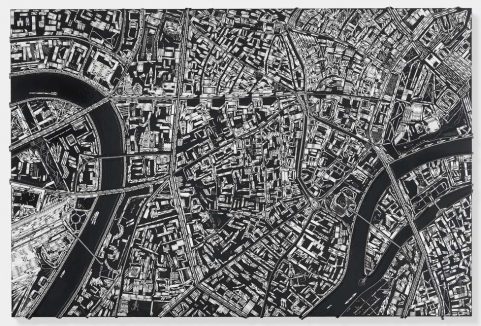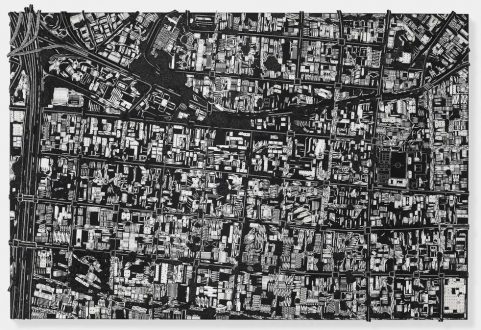ART CITIES:Sao Paulo-The Cities of Damien Hirst

“Black Scalpel Cityscapes” is the title of Damien’s Hirst exhibition in São Paulo, his works are made up of vast numbers of surgical instruments that combine to create bird’s-eye views of urbanised areas from around the world.
By Dimitris Lempesis
Photo: White Cube Gallery Archive
With this seriesof works, Damien Hirst investigates subjects pertaining to the sometimes-disquieting realities of modern life, surveillance, urbanisation, globalisation and the virtual nature of conflict – as well as elements relating to the universal human condition, such as our inability to arrest physical decay. In the paintings, manmade features and natural elements such as buildings, rivers and roads are depicted in scalpels as well as razor blades, hooks, iron filings and safety-pins, all set against black backgrounds. For this exhibition, Hirst selected 17 cities, which are either sites of recent conflict, cities relating to the artist’s own life, or centres of economic, political or religious significance. The selection includes, amongst others, Washington DC, Rome, Vatican City, Leeds where the artist grew up), Beijing, Moscow, New York and London. Each city’s particular history is written into its geographical spread, showing how it has incrementally grown and developed over the years. The paintings bear witness to Hirst’s trademark technique of patterning, systematic repetition and grids, as used in earlier series.

The “Black Scalpel Cityscapes” is a reference to the military procedure of “surgical bombing” or “surgical strikes”, commonly used in modern warfare, which aims to limit collateral damage by targeting precise areas for destruction. The suggestion of a remote, digital conflict inevitably reduces the tragic and devastating realities of war. In a similarly misleading manner, the perspective of an aerial map minimises the life beneath it to a series of detached systems and patterns of collective existence. in the modern conception of urban living. Hirst’s paintings, therefore, make inevitable allusions to the all-seeing eye, that of surveillance tools such as Google Earth, now used by approximately 500.000.000 people and whose roots are traceable to a 3D mapping application used by US military during the Iraq War. Hirst has described the steel scalpels, which have recurred in his work since the early ‘90s, as “dark but at the same time light”, a reference to the visual appeal of the highly reflective, precision-tooled metal. Playing on elements of wordplay surrounding “surgical strikes”, Hirst here uses them to dissect not only individual concerns over mortality, but the deep-rooted, society-wide anxieties over surveillance, the digitisation of warfare and the sense of a remote imposition on our individuality like the one described by George Orwell in “1984”.
Info: White Cube São Paulo, Rua Agostinho Rodrigues Filho 550, Vila Mariana, São Paulo, duration: 11/11/14 – 24/1/15, Days & Hours: Tue-Fri: 11:00-19:00, Sat: 11:00-17:00, http://whitecube.com
